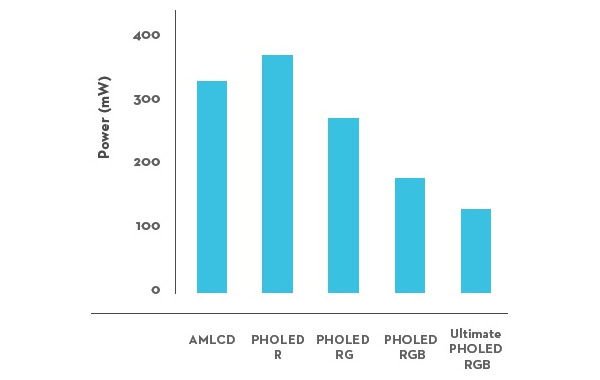Affiliate links on Android Authority may earn us a commission. Learn more.
What is PHOLED?

If you’ve been following all of the Galaxy S4 rumors and leaks then you’ve probably come across the term PHOLED display a couple of times by now. In case these rumors turn out to be true, which we’ll find out in just a few hours, then it might be a good idea to know the difference between these types of displays. That’s where this article comes in.
OLED
Just for some background information; OLEDs are solid-state electronic devices which emit light in response to an electric current.
Light is created in LEDs by a process called electrophosphorescence, whereby electrons are passed from a cathode to an emissive layer, which are used to fill electron “holes” in the conductive layer. When these holes are filled the electrons release energy in the form of a photon (light). The color of light produced and the energy efficiency of the LED is determined by the type of materials used in the emissive and conductive layers.
The difference between an OLED and a standard LED is that an OLED uses organic layers (O for organic) for a semiconductor rather than inorganic materials, which tend to be more energy efficient. Depending upon how these OLEDS are built and arranged you can produce different types of screens, such as passive or active matrix OLEDs (PMOLED and AMOLED).
Phosphorescent organic light-emitting diodes
PHOLEDs operate in exactly the same way, but opt for different materials in the light emitting layers. PHOLEDs use soluble phosphorescent molecule materials to create organic light-emitting devices, which are more energy efficient than the materials used in typical florescent OLEDs.
The true benefit from PHOLEDs comes from the fact that they can be up to four times as efficient as fluorescent variants, which would mean substantially longer battery life for smartphones which used PHOLED based displays. Convention fluorescent LEDs only emit about 25% of the excitonic energy as light, with the remaining 75% wasted as heat. But the clever engineers behind the PHOLED display developed a phosphorescent material which could convert up to 100% of the electron’s energy into light.
As a result of this very efficient energy conversion process, PHOLED based displays will also output substantially less heat than other screens. According to an example given by the developers UDC; the temperature rise in the FL-OLED TV would be about 30°C, while the temperature rise would be reduced to 10 – 17°C with PHOLED technology.
Not only do lower temperature displays help improve the lifespan of the LEDs, but it will also lower the entire temperature of your device, prolonging the lifespan of all the components inside.
However there is a considerable drawback with this technology, which comes in the form of a shortened display lifespan. The red and green PHOLEDs last a considerably longer length of time than the blue ones, often tens of thousands of hours longer. This can lead to an eventual distorting in the display’s colors, ruining the image quality for users.

This is the main reason why we haven’t seen PHOLED displays used in consumer grade electronics goods, despite the fact that the technology has been available for a few years.
Real world implementation
Fortunately there is a compromise to be found, you can always combine PHOLED and traditional OLED materials in order to bypass the lifespan problems. As I mentioned, slightly different materials are used for different colored LEDs anyway, so you can combine longer lasting red and green PHOLEDs with blue OLEDs in order to extend the lifespan of the entire display.

Even if the Galaxy S4 doesn’t end up using a PHOLED display, it’s a promising technology which will hopefully make its way into all manner of consumer grade electronics at some point the in the future.